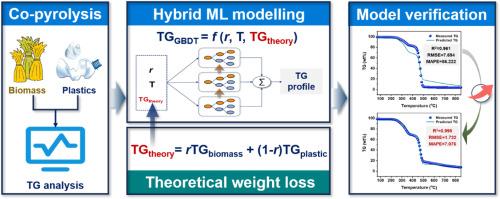使用混合规则描述符的混合机器学习方法解锁生物质-塑料共热解的协同效应
IF 5.8
2区 生物学
Q1 AGRICULTURAL ENGINEERING
引用次数: 0
摘要
共热解是回收生物质和塑料有机固体废物的一种很有前途的策略,热重(TG)曲线为共热解过程中的热动力学和协同效应提供了有价值的见解。然而,通过实验方法获得TG谱是费时且昂贵的。本研究系统分析了棉花秸秆(CS)和地膜(MF)共热解实验、热动力学和TG谱。然后,提出了一种混合机器学习(ML)模型,该模型将混合规则描述符与梯度提升决策树(GBDT)模型相结合,用于预测共热解的热重分布。结果表明,与单独热解相比,共热解不仅提高了生物炭的产率,而且降低了反应活化能。与GBDT模型相比,混合ML模型对共热解过程的预测精度较高,在外部验证数据集中R2 = 0.998, RMSE = 1.732, MAPE = 7.076。综上所述,本工作系统地研究了共热解过程,并提出了一种混合ML模型来指导有机固体废物的利用。本文章由计算机程序翻译,如有差异,请以英文原文为准。

Unlocking the synergistic effects in biomass-plastic Co-pyrolysis using a hybrid machine learning approach with blended rule descriptors
Co-pyrolysis presents a promising strategy for recycling organic solid waste from biomass and plastic, with thermogravimetric (TG) profiles provide valuable insights into thermo-kinetics and synergistic effects in the co-pyrolysis process. However, obtaining TG profiles through experimental methods is time-consuming and costly. This study systematically analyzed co-pyrolysis experiments, thermo-kinetics, and TG profiles using cotton straw (CS) and mulch film (MF). Then, a hybrid machine learning (ML) model was proposed that integrated a blended rule descriptor with a Gradient Boosting Decision Tree (GBDT) model to predict the TG profile of co-pyrolysis. Results revealed that co-pyrolysis not only enhanced biochar yield but also reduced the reaction activation energy compared to MF alone. The hybrid ML model provided excellent predictive accuracy for the co-pyrolysis process compared to the GBDT model, achieving R2 = 0.998, RMSE = 1.732, and MAPE = 7.076 in the external validation dataset. In conclusion, this work systematically studied the co-pyrolysis process and proposed a hybrid ML model to guide the utilization of organic solid waste.
求助全文
通过发布文献求助,成功后即可免费获取论文全文。
去求助
来源期刊

Biomass & Bioenergy
工程技术-能源与燃料
CiteScore
11.50
自引率
3.30%
发文量
258
审稿时长
60 days
期刊介绍:
Biomass & Bioenergy is an international journal publishing original research papers and short communications, review articles and case studies on biological resources, chemical and biological processes, and biomass products for new renewable sources of energy and materials.
The scope of the journal extends to the environmental, management and economic aspects of biomass and bioenergy.
Key areas covered by the journal:
• Biomass: sources, energy crop production processes, genetic improvements, composition. Please note that research on these biomass subjects must be linked directly to bioenergy generation.
• Biological Residues: residues/rests from agricultural production, forestry and plantations (palm, sugar etc), processing industries, and municipal sources (MSW). Papers on the use of biomass residues through innovative processes/technological novelty and/or consideration of feedstock/system sustainability (or unsustainability) are welcomed. However waste treatment processes and pollution control or mitigation which are only tangentially related to bioenergy are not in the scope of the journal, as they are more suited to publications in the environmental arena. Papers that describe conventional waste streams (ie well described in existing literature) that do not empirically address ''new'' added value from the process are not suitable for submission to the journal.
• Bioenergy Processes: fermentations, thermochemical conversions, liquid and gaseous fuels, and petrochemical substitutes
• Bioenergy Utilization: direct combustion, gasification, electricity production, chemical processes, and by-product remediation
• Biomass and the Environment: carbon cycle, the net energy efficiency of bioenergy systems, assessment of sustainability, and biodiversity issues.
 求助内容:
求助内容: 应助结果提醒方式:
应助结果提醒方式:


